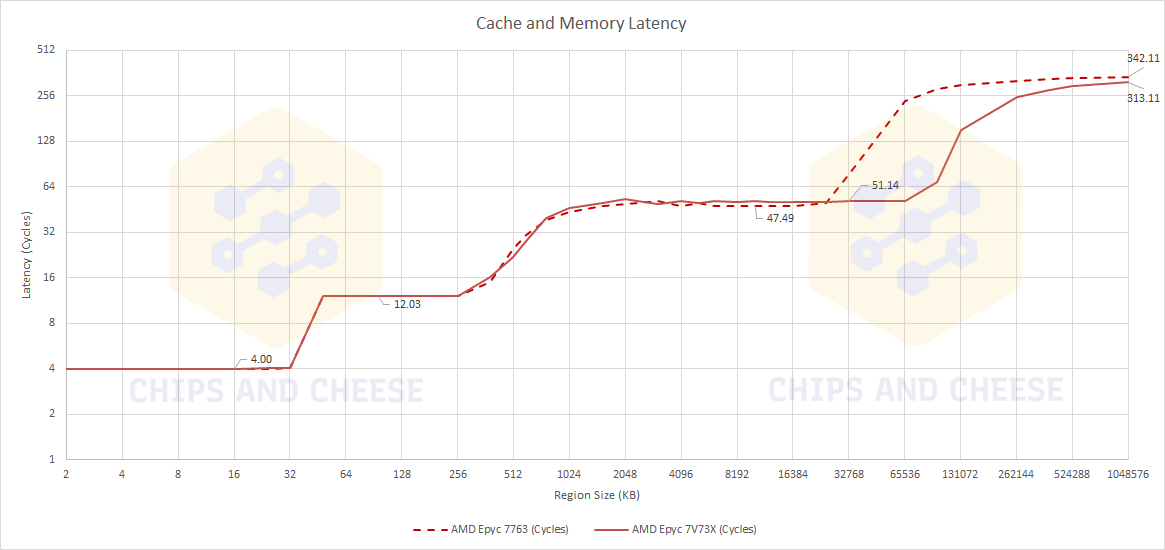AMD 3D V-Cache Tests Reveal Minimal Latency Increase, Improved Bandwidth
Chips and Cheese have tested the latency of AMD's EPYC 7V73X (Milan-X) processor with 3D V-Cache. It's the same technology coming to mainstream Ryzen processors, so the results probably foreshadow the gains we can expect from the chips, such as the Ryzen 7 5800X3D.
The rest results from Chips and Cheese revealed that 3D V-Cache has minimal impact on cache and memory latency. According to the EPYC 7V73X data, the increase resulted in three to four cycles of extra latency. That's very impressive, considering that the EPYC 7V73X (768MB) sports up to three times more L3 cache than the EPYC 7763 (256MB). The publication also noted that while Milan-X has lower clock speeds than Milan, the former boosts better, negating the latency increase from 3D V-Cache.
AMD's 3D V-Cache, which has been in development for years, allows the chipmaker to stack more L3 cache on its Zen 3 processors. The chipmaker fuses the 3D V-Cache chiplet to the top of the core complex die (CCD) through a hybrid bonding process. As a result, AMD can implement a single layer of stacked L3 cache on its Ryzen processors in its current stage. However, the technology enables up to multiple dies, so future consumer Ryzen processors could potentially arrive with vast amounts of L3 cache.


The vanilla Ryzen 7 5800X has 32MB of L3 cache. However, each 3D V-Cache chiplet carries up to 64MB of 7nm SRAM cache, so the Ryzen 7 5800X3D ends with a 96MB L3 cache, triple that on the Ryzen 7 5800X. As a result, the Ryzen 7 5800X3D has a 400 MHz and 200 MHz lower base and boost clock than the Ryzen 7 5800X. However, if Chips and Cheese's experiment is accurate, the Ryzen 7 5800X3D's higher L3 cache should muffle its lower clock speeds.
At CES 2022, AMD shared a chart where the Ryzen 7 5800X3D delivered 15% higher 1080p gaming performance over the standard Ryzen 9 5900X. In another chart, the Ryzen 7 5800X3D performed similarly to Intel's latest Core i9-12900K and even bested the Intel chip in some titles.
AMD stacks the 3D V-Cache chiplet over the CCDs. The Ryzen 7 5800X only has one CCD, which is why it only got to 96MB (32MB + 64MB) of L3 cache. Ryzen SKUs, such as the Ryzen 9 5900X that rocks two CCDs, can have up to 192MB. Milan-X, which possesses up to eight CCDs, max out at 768MB (256MB + 512MB).
AMD teased a prototype Ryzen 9 5900X with 3D V-Cache at Computex 2021 but didn't mention anything about it at CES 2022. Therefore, it's uncertain if AMD will bring the Ryzen 9 5900X3D or Ryzen 9 5950X3D to the market.
Get Tom's Hardware's best news and in-depth reviews, straight to your inbox.

Zhiye Liu is a news editor, memory reviewer, and SSD tester at Tom’s Hardware. Although he loves everything that’s hardware, he has a soft spot for CPUs, GPUs, and RAM.
-
wifiburger being a limited product and only one SKU I'm not really impressed,Reply
but... there's some recent news/post that 13th Gen Intel will come with 68mb cache -
Alvar "Miles" Udell The question is how much this increases the costs. Epyc and Threadripper it's basically irrelevant. Ryzen wise, if the average benefit is 5% and there are more than a few negative cases, and that benefit is only seen at 1920x1080, that's going to make pricing tricky.Reply
-
samopa How about heat dissipation ?Reply
I know that stacking chip over another has been done in some times, but now we're talking about stacking memory chip (relatively cool) on top of processing/computing chip (relatively hot). How the heat from the computing chip can dispersed without affecting the memory chip on top of it ? -
TechLurker Considering that they did test a 5900X3D, having both a 5900X3D and a 5950X3D SKU makes sense; helping to end AM4 on a high note while still competing well with Intel's own transitory offerings. But the 5800X3D makes more sense in the near-term simply because that one uses only one CCX die vs the two that the 5900X/5950X would use, and the binning doesn't have to be as "perfect" as the bins for the higher models. Thus, having the 5800X3D released ahead helps make use of early and less-efficient 3DV-enhanced CCXs while building enough stock of "flawless" bins for eventual 5900X3D and 5950X3D models.Reply